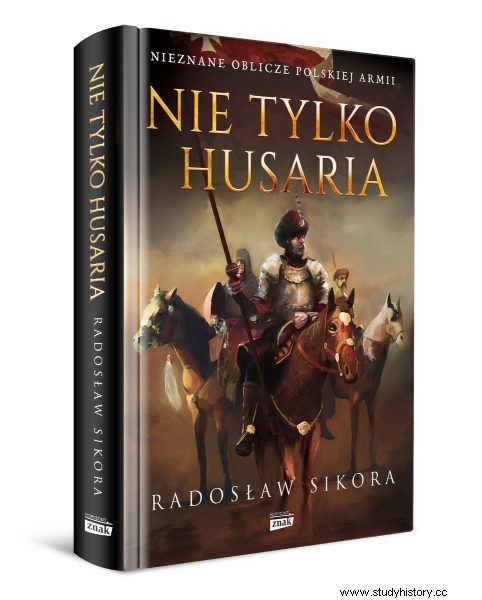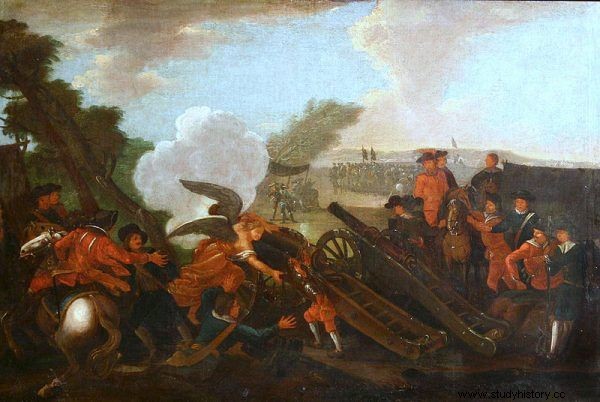Hussars - winged riders, the pride of the Polish army. Its spectacular charges have gone down in history. However, not everything we know about this unique formation is true.
Twilight of the hussars?
The twilight of the hussars was caused by the development of firearms - a very popular claim that lingers in the literature on the subject. Nothing could be more wrong . Detailed analyzes of the battles that would prove this thesis show that neither the fire tactics of Gustav II Adolf's troops (firing several musketeer ranks at once), nor the decades later rearming of the infantry from link muskets with rapid-fire flint muskets contributed to the fall of the hussars. There is no question of shooting her ranks, as some write.

The article is an excerpt from the latest book by Radosław Sikora Not only hussars which has just been released on the market
(…) Until the beginning of the 1870s, the hussars retained their traditional character, ie the armored cavalry cavalry. She presented herself in this way for the last time on September 16, 1784, and one of the last battles was fought near Krotoszyn on June 14, 1768. Andrzej Maksymilian Fredro thought about such hussars when he wrote in the second half of the 17th century:and Vsarza stays, there will be a Pole, the Lord in the field, if the copy will die, the Pole's virtue will perish ".His words turned out to be prophetic. The liquidation of the hussars was preceded by the erasure of Poland from the map of Europe . And when did this happen? In 1775, the Seym passed an increase in the size of the Commonwealth's army to 30,000. soldiers, of which 22 thousand. in Korona and 8 thousand. In Lithuania. It was then that the name "Kawaleryi Narodowey" was used for the first time. On this basis, the vast majority of historians (myself included) claimed that this meant the transformation of the hussars and armored vehicles that had existed so far into a new type of cavalry, and thus the end of the existence of hussars. It turns out, however, that the very name "hussars" functioned several years after the creation of the national cavalry.
Unknown facts
The Hussars did not lose any battle in the first 126 years of their existence in Poland - this erroneous view resulted from the interpretation of the title of Jerzy Teodorczyk's article Bitwa pod Gniewem (September 22–29 September 1626):the first defeat of the hussars. Meanwhile, neither the battle of Gniew was a defeat for the hussars, much less the first lost battle in which this formation participated. Polish hussars took part, for example, in the battle with the Muscovites at Dobryniczami (January 31, 1605). Nevertheless, the troops of Dmitri Samozwaniec lost.
Hussars are hard skating - this popular term is only true in part. Hussars was the heaviest type of cavalry, the so-called in Poland in the 17th century, but it was not a heavy ride in the sense that neither the Hussar horses nor the armament of cavalrymen were heavy. The hussar horses were referred to as "tall", meaning that they were taller than the horses of the light cavalry. But these hot-blooded and agile hussar steeds were not the heavy, cold-blooded horses they are sometimes associated with. On the other hand, the mass of armaments and equipment that they had to carry on their backs in the 17th century was not at all greater than the mass of armaments and equipment that were carried by "light" horses in Polish fiefs in the 20th century.
On the other hand, hussars were used for frontal, breaking charges, which was a typical task for heavy cavalry.
Hussars were not used only in the Commonwealth. Although it is true that it celebrated its greatest triumphs in the Polish-Lithuanian state, that it only took on its special face in the Commonwealth and that it fought here longer than in other countries, the formation came to us from Serbia and Hungary . It has evolved, inter alia, under Hungarian influence. Husaria for several decades was also owned by Muscovites (although sources are silent about its successes). We can boast that we had the best hussars in the world, but not that, apart from Poland and Lithuania, there was none.

Battle of Kliszów
***
The last battle of the hussars was not at all the Battle of Kliszów in 1702 The truth is that after 1702 the hussars not only took part in battles many times, but also sometimes won . An example is the battle with the Swedes, which was fought at Chybice in 1704.
***
A hussar is not a hussar! Hussars are not hussars or hussars! How often these two completely different types of cavalry are often confused today. Hussar - in the 17th century Polish it was said and written "usarze" - this is a copier's cavalry, usually wearing plate protective armament . Hussars are light cavalry, with no lance or no armor.
Problems of hussars
The problem with the hussars, as with all cavalry, was that could not fight in all terrain conditions . Ramparts, Spanish billy goats, cobylins (or cobylits), wide ditches and other obstacles made it impossible to ride. So while the hussars were second to none in the open field, the intelligent opponent was able to adapt his tactics to this situation and instead of fighting in the field, he hid behind obstacles.
This is what Gustaw Adolf usually did in Livonia and Prussia in the 1720s. This was also what the Moskvicins did near Smolensk, where, for example, on September 7, 1633, most of the hussar rot did not take part in the fight:
[...] because the enemy could not look at them from a distance, Moscow immediately fled from the field, when they hurried towards them [approached them] the usurs.
On that day, when the hussars could not provoke the enemy to a general trial in the open field, they declared that they would dismiss their horses for foot combat:
Usarian rots, or there was no place for this for dense ditches and hills and brushwood, and you did not [live] or struggle [to fight] with them [avoided] and loves his obvo [dem?] he showed a little after a riot of USSR rushed towards him, he was quickly giving way to his stratagems [artificial or terrain obstacles], but [the hussars] were doing enough of himself. The gentlemen of the army and the horses, dismounting on foot to attack the enemy, offered themselves, but by the grace of God it was not necessary [...].

The article is an excerpt from the latest book by Radosław Sikora Not only husaria which has just been released on the market
